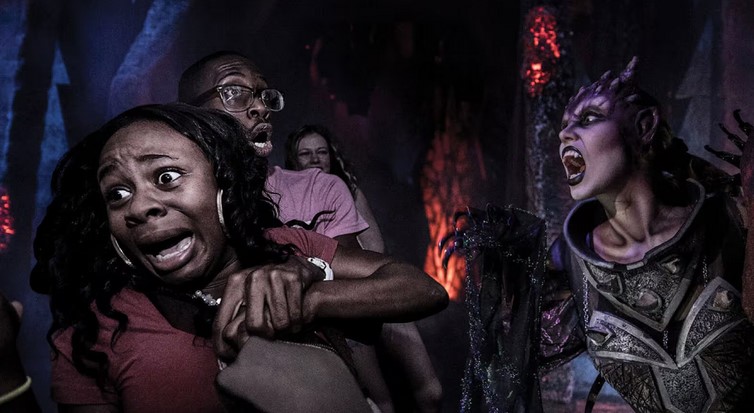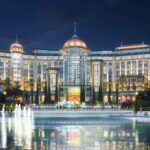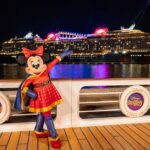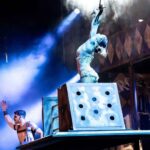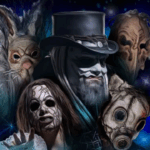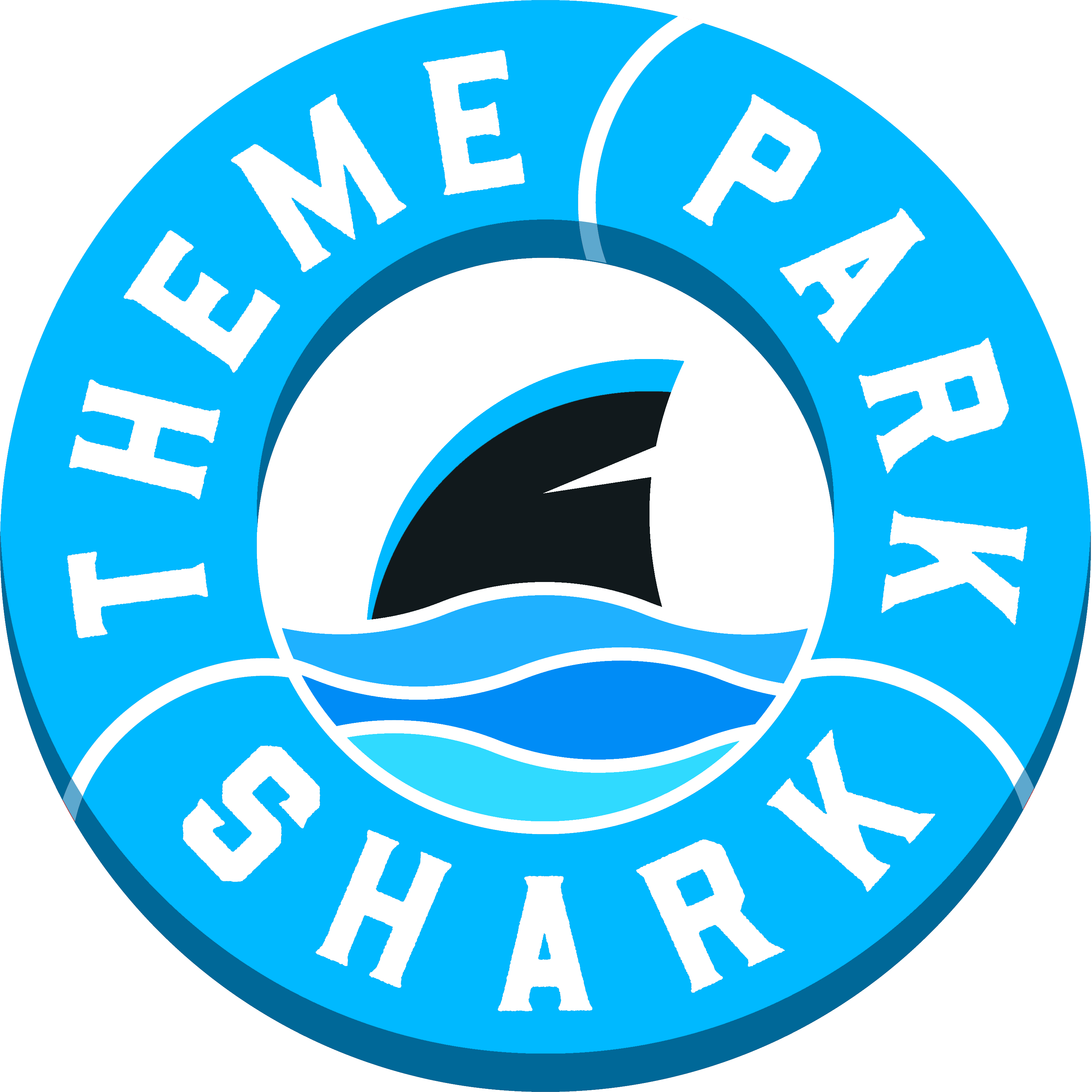While Universal Studios Prides itself on being one of the most intense and immersive Halloween Events in the country, other big names in America’s theme park landscape have also endeavored to bring high quality scares to the table. Most notably, Knott’s Berry Farm, which transforms every year into Knott’s Scary Farm, has cracked the code on one of the most quintessential accessories to make navigating these events less cumbersome for those with certain sensitivities: The No Boo Lanyard. A simple accessory, which often sells for under twenty dollars, allows scareactors to identify guests who wish to be left alone outside of the headliner mazes, allowing them to enjoy the event without the added stress of navigating a veritable minefield of terror.
Some may find the idea of a No-Boo Lanyard laughable; after all, doesn’t such an accessory completely negate the reason guests would attend a Haunt event in the first place? But everyone’s circumstances are different, and criticizing something simple that doesn’t detract from or diminish the experiences of others is a fruitless effort. From guests who love horror but struggle with physical or mental disabilities to first-time guests who aren’t sure if the event would really be their speed, to guests who simply don’t like being scared by scareactors, the core of the support for accessibility tools like the No-Boo Lanyard boils down to the idea that guests should be given every chance to enjoy such a fun, unique, and beautifully crafted event.
However, not all Haunt events offer tools like the No-Boo Lanyard, and even those that do still tend to be difficult to navigate for individuals with specific sensitivities and disabilities. Fog, strobe, and the overwhelming burden of navigating the theme parks during these exceptional haunt events can be daunting for some. For these individuals, navigating the park comes down to a series of tricks that make the experience more manageable. A lot of it comes down to knowing your own limits, and the solution for one guest may not help another – but increasingly, as guests flock to events like Halloween Horror Nights for the thrill of exceptional set design, atmosphere, and creative storytelling through physical medium, those with exceptional needs find themselves looking for ways to make these events not just bearable, but as thrilling as they can be.
So let’s talk.
Understand What You’re Up Against
One of the easiest ways to prepare for the season of haunts and scares is to do your research into the event before attending; as straightforward and obvious as this sounds, research into what the event actually entails can be more in-depth than most expect. Within the first week or two of the event, there are typically at least a few video walkthroughs of the year’s houses posted on video streaming sites like YouTube. This allows any guest or their trusted third party to pre-screen the houses, to determine the severity of the house and what elements they might struggle with.
Pre-screening houses is particularly useful for guests with strobe sensitivity; doing so allows guests to determine how much strobe is used in a house before being immersed in a potentially harmful environment. Pre-screening houses can give guests more control over the environment in which they experience these strobes, and allows guests with strobe sensitivity to enter houses with more confidence, knowing which houses are low-strobe, which houses are well-lit, and which houses are out of their tolerance range long before they ever step foot in the houses. Guests with photosensitivity should always take care when pre-screening houses, or have a trusted, non-photosensitive third party pre-screen them.
Pre-screening can also help determine if content triggers exist in a house – while not all the details may be visible on a particular walk through, guests can determine if larger set-pieces and broader themes may be safe for them to encounter. By doing preliminary research like this, understanding the elements that may turn a night of spooky fun into an uncomfortable or harmful experience, guests can better control the experience that they have at haunt events.
Know Where to Rest
One of the most valuable tools one can have when trying to navigate Halloween Horror Nights is an understanding of the park; for many parkgoers, this is a non-issue. Faithful Universal fans and Frequent Fear passholders all know the ins-and-outs of the park as well as they know the back of their own hands. But for new guests, or those who may not be as familiar with the layout of the park and its terrifying nighttime transformation, knowing where to go to unwind or recover from a particularly intense experience can be crucial.
Places like Fast Food Boulevard in Springfield, The Leaky Cauldron in the Wizarding World of Harry Potter, Richter’s Burger Co. on San Francisco’s bayside, and the Today Cafe at the front of Hollywood Boulevard are great places to escape the scares and relax with a bite to eat, or a refreshing beverage. Many restaurants remain open for the duration of the event, and while some places will be more crowded than others – Louie’s Pizzeria will be packed to the gills, whereas The Leaky Cauldron is usually a ghost town during Halloween Horror Nights – all of the restaurants scattered around Universal Studios Florida are a safe bet to escape the pressures of the crowds, the scareactors, and the overall atmosphere of Halloween Horror Nights.
In addition to utilizing the restaurants as designated cool-down spots, there are quite a few unofficial quiet areas in Universal Studios, as well. With the majority of park guests queuing for houses or experiencing the thrills of the scare zones, certain places are left nearly empty, for those who need a moment of quiet calm to steel their nerves. Most of Diagon Alley tends to be empty and quiet (when the Death Eaters aren’t stalking the streets) and the Men in Black gift shop is also relatively quiet during the event. The photo shop at the front of the park is rarely busy, and the same can be said for the Amazing Pictures shop on San Francisco, when open. While not designated ‘quiet rooms,’ these locations around the park tend to be out-of-the-way and are rarely frequented by guests who are more interested in being in the middle of the action.
However, for guests who need a little extra solitude to come down from sensory overload within the park, Universal Orlando has an official Quiet Room for a break from the sights, sounds, and smells of an overwhelming theme park experience, either during standard day admission or during Halloween Horror Nights.
This Quiet Room is located at the front of the park, near Health Services at Universal Studios Orlando, and operates on a first-come, first-served basis.
Know Your Limits
Knowing your limits is an incredibly important part of navigating Halloween Horror Nights, and can make or break a night. If a guest feels that a break is in order – whether it be due to overstimulation, increased anxiety, or physical duress – then taking that break is the best thing to do for the night. Pushing past one’s limits during an event as intense and demanding as Halloween Horror Nights can quickly sour the experience, and make continuing the night more difficult than it needs to be.
Cold water is available for free at any Coca-Cola Freestyle Machine within the park (no special cup necessary!), as well as at any beverage stand that serves fountain drinks, so remember to stay hydrated during the long stretches where guests are queued in the heat, and wear comfortable, breathable clothing with a light sweater on hand for when the cooler interior of houses and restaurants brings on the wrong kind of chills. Determine ahead of time what you are willing to endure and if the 120-minute standing wait for the house you really want to experience will make the rest of the night more difficult. Remember that all the usual rules and hardships of theme park queuing applies to Halloween Horror Nights houses, except most of the queues are entirely outdoors and far hotter, more cramped, and more drunk than your typical attraction queue might be. Guests with emetophobia beware Fridays and Saturdays at the event, where many guests may feel more comfortable drinking excessively. While the cleaning and sanitation staff are always on top of ‘protein spills’ around the park, an encounter with a guest who is feeling unwell is an unfortunate possibility that can potentially sour a night.
Sidewalks
Sidewalks are you friend; in addition to typically being less crowded than the streets, sidewalks – especially in locations like New York and San Francisco – tend to help mindful guests avoid things like fog effects and the vast majority of scareactors. For those concerned about breathing in an alarming amount of fog vapor, walking the sidewalks can help drastically reduce the amount of fog experienced during the event, especially in the first few weeks where the machines tend to belch out more fog than usual.
In addition to not sucking down an entire bottle of fog juice every time you walk through a scarezone, walking the sidewalks also helps those who are simply trying to get from point A to point B without too much scareactor engagement. Most – but not always all – of the scareactors focus their efforts in the streets, where the crowds tend to be thickest. While not a completely fool-proof technique, it certainly reduces the interactions guests might have with roaming hoards, scareactors, ghouls, and chainsaw-wielding maniacs on average.
Personal Aid Equipment
Never be afraid to bring and utilize your personal accessibility equipment at Halloween Horror Nights. Increasingly, guests are using accessibility equipment like noise-cancelling headphones at the event to personalize the level of stimulation they experience. For a guest with photosensitivity, strobe-reducing polarized sunglasses can make the event more manageable, even if a guest feels confident that their plans for the night will be strobe-free. Sometimes, just having the reassurance of personal aid equipment with you can be enough to help ease the mind and make the night more enjoyable.
The use of larger personal aid equipment, like mobility devices, is also important to consider when discussing accessibility at Halloween Horror Nights and similar haunt events. With houses and mazes often being designed to evoke feelings of claustrophobia and spatial confusion, wheelchair users will be happy to know that all of the houses at Halloween Horror Nights are reported by a Universal Representative to be wheelchair accessible. However, while electric wheel chairs are not allowed inside of the houses, manual wheel chairs are stationed at each house and are available for guest use when the need arises.
While the houses are considered wheelchair accessible, it’s also important to note that many houses have adverse environmental conditions like low visibility, tight corners, twists and turns, and – on the rare occasion – uneven flooring. Wheelchair users will need to be mindful of these obstacles in order to maximize both their scares and their safety during the intense experiences within houses.
Those who require the use of mobility aids or who struggle with other disabilities that make navigating the theme parks difficult should explore their options in-park and contact a park representative about their options. Attraction Assistance Passes are designed to make navigating the park easier for those with certain disabilities, such as wheelchair users, those with chronic pain or sensory issues, and those for whom prolonged standing or walking may not be entirely feasible. Guests eligible for the Attraction Assistance Pass will need to register for it through the International Board of Credentialing and Continuing Education Standards (IBCCES) up to 30 days and at least 48 hours prior to their arrival to the park, so planning ahead is an absolute must for individuals with disabilities. THE IBCCES requests “a statement (with your name visible) from an educational, healthcare, or governmental provider or agency indicating any special accommodations or supports needed” upon registration.
While requiring guests to provide documentation of their need for accommodations may be a hindrance for some – especially those undiagnosed or without relevant medical records pertaining to their accessibility needs – the IBCCES Attraction Assistance Pass does actually cover an impressive rang of accessibility needs.
With the Attraction Assistance Pass applying to both the standard Universal attractions and the Halloween Horror Nights houses and shows, those who may need it should contact guest services at the front of the park or via phone to learn more about Universal’s Accessibility options.
Check Universal’s official page on accessibility and accessibility guidelines at the link below:
https://www.universalorlando.com/web/en/us/plan-your-visit/accessibility-information
Planning Your Trip
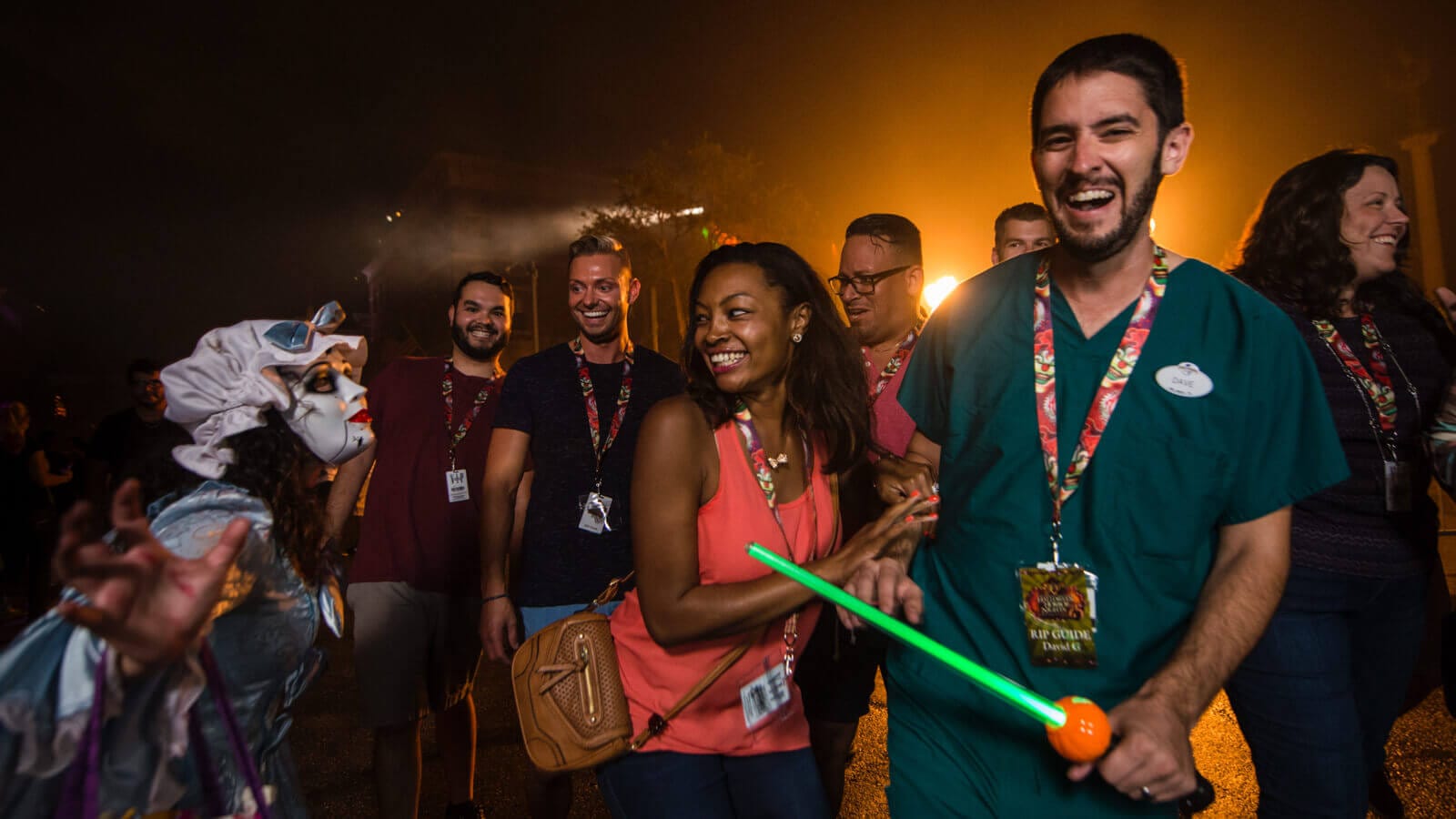
With all of this in mind, it’s then important to determine when you want to visit Halloween Horror Nights, and how you plan to maximize your experience in the parks. If you are a Florida Resident and hold a multi-night ticket, there’s less pressure to plan the perfect HHN run, but for guests who may not have the opportunity to shoot for a full season of spooks and scares, understanding how to best maximize your experience at Halloween Horror Nights is a must – especially for those who have to factor in the added challenge of accessibility. For those intending to purchase an express pass for the event or who plan to purchase an R.I.P. Tour experience – both of which can run into the hundreds of dollars per person, depending on the night – the perfect run isn’t necessary. But for guests without these extras planned into their trip, proper planning is more important than ever.
It’s no secret that weekends tend to be busier. For anyone who struggles with crowds, claustrophobia, or overstimulation, a weekday excursion is likely to be met with smaller crowds and an easier, more enjoyable time. With the exception of extenuating circumstances, like Halloween falling on a Monday, Halloween Horror Nights runs only Wednesday – Sunday (with Mondays and Tuesdays typically seeing the event closed). Wednesdays, Thursdays, and Sundays tend to be the less-crowded days, as fewer park guests push themselves into late night park-going with the workday looming over them the next morning. For guests visiting on vacation with limited time and a dislike of crowds, choosing a Wednesday, Thursday, or Sunday can prove much more enjoyable than choosing a Friday or Saturday.
October 31st, in fact – Halloween itself – tends to have fewer crowds than, for instance, the week leading up to Halloween. With so many Halloween parties and alternative (and cheaper) venues offering Halloween activities on the big night, the park tends to be a little more empty than usual. Your mileage may vary, of course, especially depending on what day of the week Halloween may fall on in any given year, but in the past, the headliner holiday has shaped up to be an enjoyable, low-stress experience.
Skip It
At the end of the day, your health and safety must come first. While Universal Orlando has taken leaps and bounds in the last few years to make their most popular marquee event accessible to as many people as possible, there are still some things left to be desired.
The strobe in a particular house may still trigger a guest’s photosensitivity. The metal bleachers in the Fear Factor stadium may still be difficult to sit in for prolonged periods of time for guests with chronic pain. The house with the 120 minute wait might still be difficult to queue for.
As much as nobody wants to hear that sometimes, the best thing you can do is not do something, no haunt experience is worth putting yourself at risk. Sometimes, the best thing you can do for yourself is skip something if you feel like it might jeopardize your health, comfort, or safety. Skip that house with heavy strobe; go around the scarezone with low visibility. Enjoy your night to the absolute fullest you can without pushing yourself past your limits or putting yourself in harm’s way, and then – once you’ve had all the frights you can handle – visit guest services.
Typically, guests may receive a survey email a day or two after attending an event like Halloween Horror Nights. For disabled individuals, answering these emails comes with additional incentive. We all want to see a more inclusive, more accessible culture in theme parks and haunt events like Halloween Horror Nights, and answering these emails is encouraged!
But if you have the time and are able, a quick stop at Guest Services, located at the front of the park, is a more direct action than the online surveys. Tell a Guest Services Representative about your night.
There’s plenty to be afraid of at Halloween Horror Nights, but that should never include speaking up about the park’s accessibility. Feedback from disabled guests, or guests who otherwise struggle with certain aspects of the event’s design, is paramount to Universal being able to create bigger, better, spookier, and more inclusive events in the future. While Universal Creative does an outstanding job every year bringing these horrors to life, guest feedback – good and bad – plays an important role in how the creatives behind Orlando’s scariest Halloween Haunt event plan, design, and execute concepts and attractions.
Tell them what you struggled with, what can be improved… and most importantly, tell them what was done right. Not only are those positive comments important for Universal Creative to understand how best to create these spaces and experiences in ways that include and entertain everyone, but you never know… you might make someone’s night by talking about your own positive experience!


